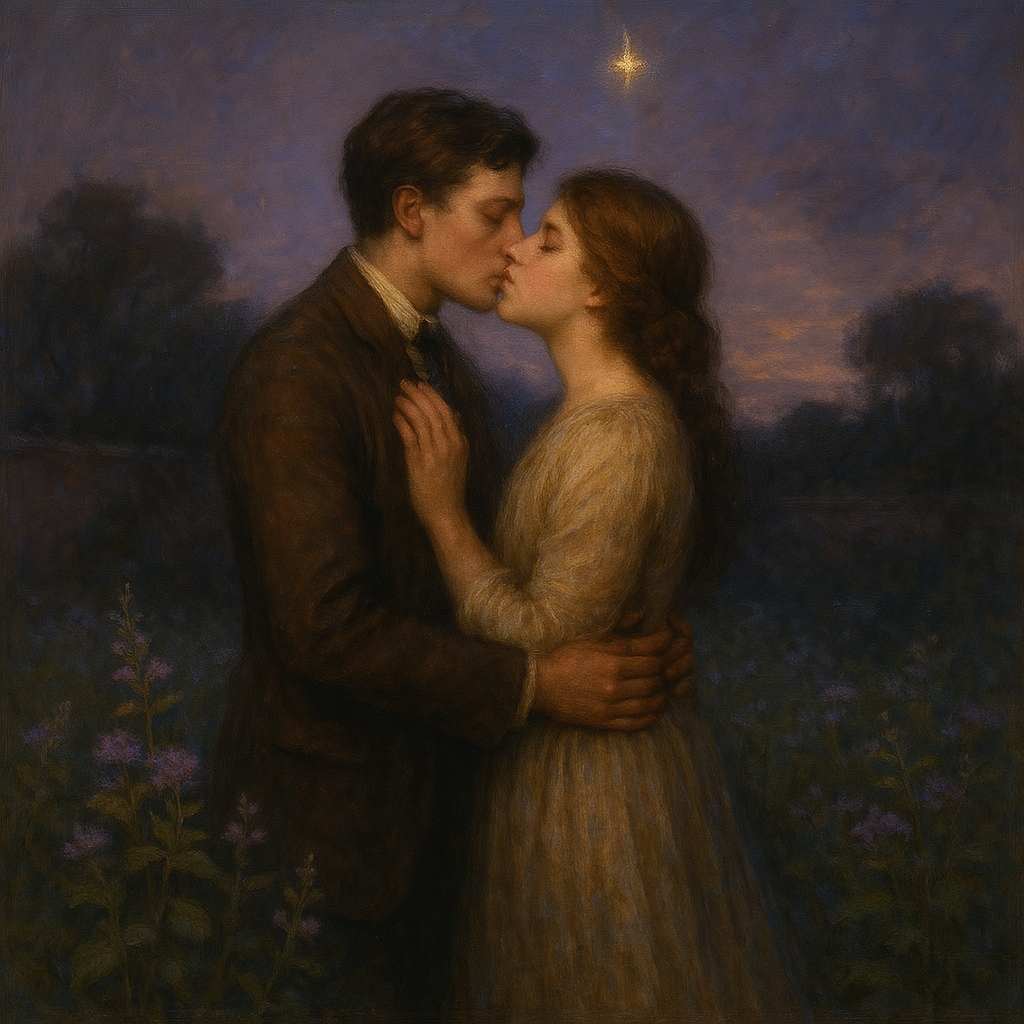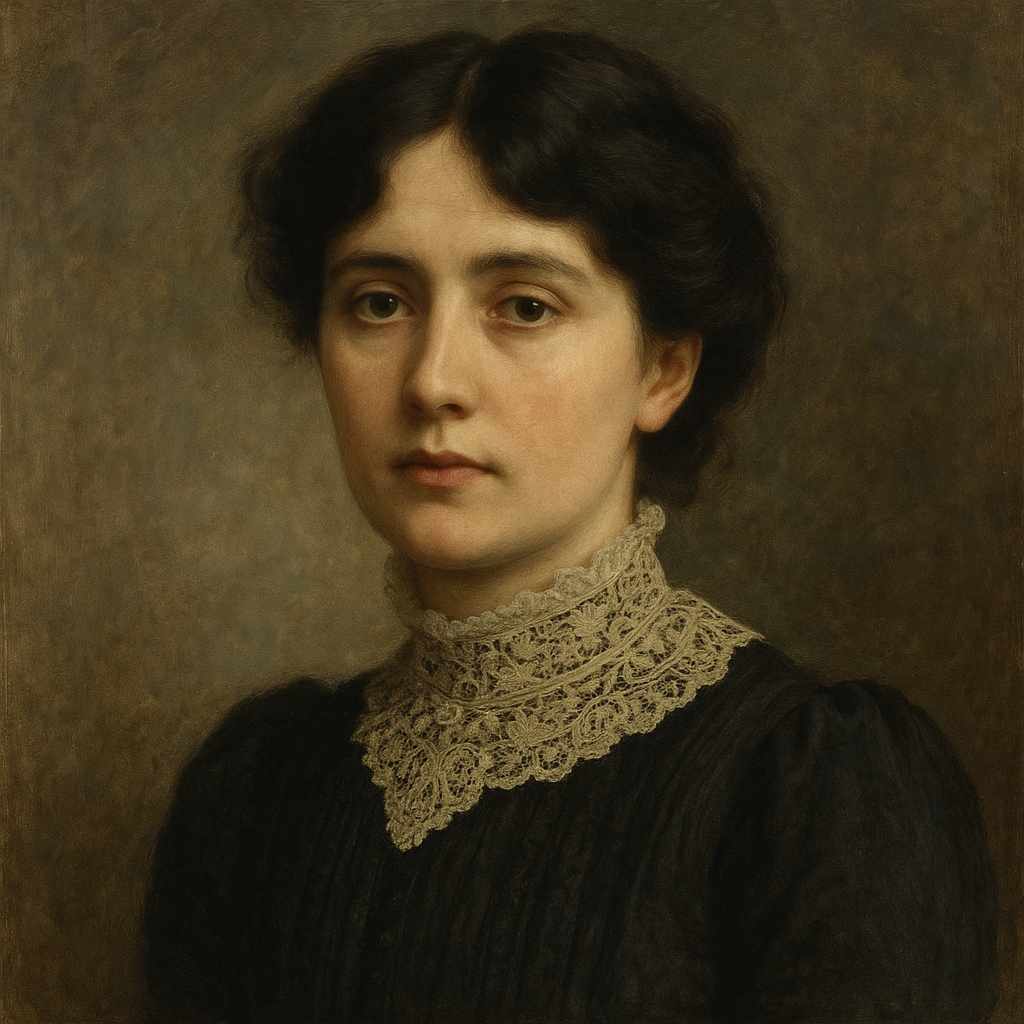Love in September
Nora Hopper Chesson
1871 to 1906

The garden lay about us twain
Hoarding its sweets up for the rain;
We clung together, you and I,
And heard the minutes hurrying by.
Heart against heart beat heavily,
Your eyes through twilight sought for mine,
My lips drank love from yours like wine.
Our lips together met and clung —
Our love stood beautiful and young
And watched us while the minutes spun
Webs of delight not yet undone,
While our lips, kissing, would not part;
While all the night beat like a heart
Fuller of fire than any sun;
And one great star and only one
Above us for a lantern hung.
My hand in yours so closely lay,
I felt your pulse beat like my own;
I breathed your breath, and in my brain
The seed of your own thought was sown.
The garden walls seemed far away,
The scent of flowering mint was blown
About us in the gloaming gray,
About us as our lips clung close
As flash and peal, as bee and rose.
But flash and peal and cloud were not.
Twilight and scent for us begot
Delicate dreams, and for our sake
No bat, or buzzing chafer came
The happy silences to break.
We kissed, and to the lighted room
Came, carrying with us like perfume
As lovely as the rose's name,
The memory of the twilight sweet
In shining eyes and laggard feet.
Nora Hopper Chesson's Love in September
Nora Hopper Chesson’s Love in September is a lyrical meditation on intimacy, temporality, and the sensory richness of romantic love. The poem captures a suspended moment between two lovers in a garden, where time seems both fleeting and eternal, and where physical closeness blurs the boundaries between self and other. Through vivid imagery, synesthetic language, and an interplay of light and shadow, Chesson crafts an atmosphere of tender intensity. This essay explores the poem’s historical and cultural context, its literary devices, thematic concerns, and emotional resonance, while also considering its place within the broader tradition of love poetry.
Historical and Cultural Context
Nora Hopper Chesson (1871–1906) was an Irish poet whose work often engaged with Celtic folklore, romanticism, and themes of love and loss. Writing during the late Victorian and early Edwardian periods, she was part of a generation of poets who straddled the aestheticism of the fin de siècle and the emerging modernist sensibilities of the early 20th century. Love in September reflects the lingering influence of Romanticism—particularly in its celebration of nature as a backdrop for emotional experience—while also anticipating the more introspective, imagistic poetry of the modernist era.
The poem’s setting—a garden at twilight—evokes the Victorian fascination with liminal spaces, moments of transition that symbolize both beauty and impermanence. September, as a temporal marker, reinforces this theme: it is a month of decay and harvest, of endings and lingering warmth. The lovers’ embrace is thus framed by the inevitability of change, lending their passion a bittersweet urgency.
Literary Devices and Imagery
Chesson employs a rich tapestry of sensory and figurative language to immerse the reader in the lovers’ shared experience.
1. Synesthesia and Sensory Blending
The poem frequently merges sensory impressions, creating a dreamlike fusion of touch, taste, and sound. The line "My lips drank love from yours like wine" conflates taste and emotion, suggesting that love is both intoxicating and nourishing. Similarly, "the night beat like a heart" transforms an auditory sensation (the pulse of the night) into a tactile one, reinforcing the poem’s preoccupation with bodily closeness.
2. Natural Imagery as Emotional Metaphor
The garden is not merely a setting but an active participant in the lovers’ communion. It "hoard[s] its sweets up for the rain," implying both abundance and impending loss—a metaphor for the lovers’ own fleeting joy. The "flowering mint" and "rose" serve as olfactory and visual anchors, grounding the poem in a tangible, sensual reality while also symbolizing love’s ephemeral beauty.
3. Light and Shadow as Temporal Markers
The "gloaming gray" and the "one great star" create a chiaroscuro effect, where darkness and light coexist. This interplay mirrors the lovers’ emotional state: their love is luminous ("fuller of fire than any sun"), yet it exists within the encroaching dusk, a reminder of transience. The star, functioning as a "lantern," suggests guidance and constancy, a single fixed point in the shifting night.
4. Paradox of Time
The poem oscillates between moments of stillness and motion. The "minutes hurrying by" contrast with the lovers’ suspended embrace, where time seems to weave "webs of delight not yet undone." This tension reflects a universal human desire to arrest fleeting happiness, to make the ephemeral endure.
Themes
1. Love as a Transcendent, Yet Fleeting Experience
The lovers exist in a liminal space where the boundaries between self and other dissolve: "I felt your pulse beat like my own; / I breathed your breath." This merging suggests an almost mystical union, reminiscent of Romantic and Platonic ideals of love as a dissolution of individuality. Yet the poem’s temporal markers—September, twilight, the "minutes hurrying by"—underscore the inevitability of separation.
2. Nature as Witness and Mirror
The garden is both a sanctuary and a silent observer of the lovers’ passion. Unlike traditional pastoral poetry, where nature often serves as an idyllic escape, Chesson’s garden is intimate and enclosed, a private world where even the "bat, or buzzing chafer" refrain from intrusion. This selective harmony between human emotion and natural setting suggests a momentary alignment of inner and outer worlds.
3. Memory as Preservation
The final stanza shifts from the immediacy of the garden to the lovers’ return to a "lighted room," carrying with them the "memory of the twilight sweet." Here, Chesson implies that while the moment itself cannot last, its emotional residue lingers—like perfume or "the rose's name." This aligns with the Victorian preoccupation with memory as a means of defying time’s passage.
Comparative Analysis
Love in September invites comparison with other love poems that explore similar themes of fleeting intimacy. John Keats’ Ode to a Nightingale shares Chesson’s concern with temporal beauty and the desire to escape time’s ravages, though Keats’ tone is more melancholic. Christina Rossetti’s Echo also deals with memory and longing, but where Rossetti’s love is spectral and unfulfilled, Chesson’s is vividly present, if transient.
A more contemporary parallel might be found in the works of Edna St. Vincent Millay, whose sonnets often capture love’s intensity alongside its inevitable dissolution. Chesson’s poem, however, lacks Millay’s cynicism; her lovers are not disillusioned but rather suspended in a perfect, if temporary, unity.
Philosophical and Emotional Resonance
The poem’s emotional power lies in its ability to evoke both ecstasy and melancholy. The lovers’ closeness is rendered with such tactile immediacy that the reader almost feels the "pulse beat like my own," yet the awareness of time’s passage lends the poem an undercurrent of sorrow. This duality aligns with the German concept of Sehnsucht—a longing for an unattainable, perfect moment.
Philosophically, the poem engages with the tension between presence and absence, a theme explored by thinkers like Martin Heidegger, who argued that human existence is defined by its temporal finitude. The lovers’ attempt to arrest time through touch and memory is, in essence, a defiance of this finitude—a fleeting victory against inevitability.
Conclusion
Love in September is a masterful exploration of love’s sensory and emotional dimensions, framed by the inexorable passage of time. Through lush imagery, synesthetic language, and a delicate balance of light and shadow, Chesson captures a moment of perfect intimacy while acknowledging its transience. The poem stands as a testament to the Victorian fascination with memory and nature, yet its emotional depth and lyrical precision ensure its relevance beyond its historical moment. In the end, Chesson does not merely describe love; she allows the reader to inhabit it, to feel its pulse, taste its wine-like sweetness, and mourn its inevitable passing—all within the span of a twilight garden.
This text was generated by AI and is for reference only. Learn more
Want to join the discussion? Reopen or create a unique username to comment. No personal details required!



Comments
No comments yet. Be the first to comment!